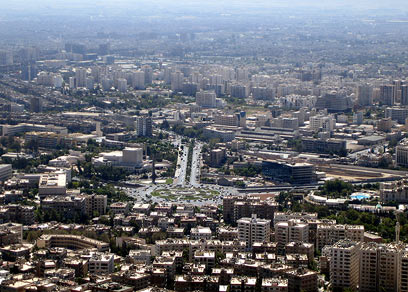


Geography
Eastern Syria is largely covered by desert, while northern Syria is intersected by the Euphrates River, which runs from Turkey to Iraq, and two additional large rivers which run from Turkey into the Euphrates. 300 kilometers of the Al-Jazeera Heights, spanning northeast from the Euphrates to the Upper Tigris, belong to Syria.
In the southwest, adjacent to the confluence of the Syrian, Lebanese and Israeli borders, Mount Hermon reaches an elevation of 2,814 meters. The Anti-Lebanon Mountains lie north of the Hermon along the Lebanese border. Several short rivers descend eastward from these mountains, irrigating the fertile valleys below; the largest such valley is the Damascus Basin.
Second largest city in Syria, Halab (Aleppo). A World Heritage Site (Photo: Visual Photos)
To the southeast, along the Jordanian border, the Horan or Jabal el Druze (“Druze Mountain”) range of volcanic mountains and hills reaches an elevation of 1,800 meters. In the north, the Anti-Lebanon Mountains continue until the Zaviya Hills, which lie to the east of the Bekaa and the Assi River Valley. The western Ansaria Mountains (elev. 1,562 meters) reach the Turkish border.
Economy and Resources
Syria’s economy is chiefly based on agriculture and oil exports. In the coastal plain, the Orontes Valley, and the Damascus Basin, irrigation is employed to raise fruits and vegetables. However, the primary crops are cotton and grains, which are mainly grown in the Al-Jazeera area and irrigated by water from the Euphrates. During the mid-1970’s, the Euphrates Dam was built, and a large lake was created. The exploitation of these waters remains a bone of contention between Syria, Turkey, and Iraq.
Syria’s chief, and virtually only, natural resource is oil, which was discovered during the 1950’s. In 1968, oil pumping was initiated in the Northeast, close to the Iraqi border. Little is manufactured in Syria; textile is the primary industry. In addition, there are a few large plants for processing agricultural produce.
Syria’s desperate economic situation results from the country’s inability to achieve economic growth commensurate with its population growth rate. President Bashar Assad initiated steps to strengthen the country’s private sector and introduced a certain degree of private banking. However, these reforms did not significantly improve Syria’s economic situation. After Saddam Hussein was overthrown, Syrian oil and merchandise smuggling ceased, and, as a result, the Syrian economy lost an estimated annual income worth several hundred million dollars.
History
In October 1918, right before the end of World War I, the British army under General Allenby captured Syria from the Turks. In 1920, the country became a French Mandate, based on a League of Nations decision and in accordance with the Sykes-Picot Agreement, a confidential French-British agreement signed in 1916, which also delineated the Land of Israel’s northern border. Independence was meant to follow quickly thereafter, but the French were reluctant to relinquish their influence in the area. In 1925, the so-called Large Druze Revolt broke out and soon evolved into a national uprising, which was finally crushed two years later.
During World War II, Syria was controlled by the collaborative Vichy French government, until the British and the Free French Forces captured the territory in 1941. Although the Free French declared that they intended to relinquish power, they did not leave Syria until 1946. On April 17 of that year, Syria declared independence. Shukri al-Kuwatli, a leader of the 1925 uprising, became the first president.
Birdseye view of Damascus (Photo: Ron Ben Yishai)
In 1948, Syria participated in the Arab invasion of Israel, and the Syrian army captured Mishmar HaYarden and Tzemach. The subsequent Armistice Agreement obligated Syria to retreat from the area, which was declared a demilitarized zone. The controversial arrangement led to numerous clashes from the 1950’s through 1967.
The twenty first years of Syria’s independence were characterized by political instability. In 1949, General Husni al-Zaim rose to power. Several months later, he was deposed in a coup led by Adib al-Shishakli, and in 1950, Hashim al-Atasi was appointed president. In 1951, Shishakli regained power and turned the country into a military dictatorship. In March 1954, he was once again ousted, and Atasi was appointed president for a second time. During this period, Syria forged close ties with the Soviet Union, which provided Syria with a great deal of aid.
In 1958, Syria formed a union with Egypt called the United Arab Republic; Gamal 'Abd al-Nasser was elected president. However, conservative Syrian nationalists vehemently opposed the merger, and a 1961 military coup led to its unraveling. During an additional uprising in 1963, the socialist al-Ba’ath Party, which sought a federation with both Egypt and Iraq, came to power, but the alliance did not materialize.
Syria's relationship with Israel
Since declaring independence, Syria has adopted a policy of belligerence and aggression towards Israel. During the 1960’s, until the Six Day War, Syrian shells constantly rained down on the Hula Valley, and attempts were made on Israeli vessels in Lake Kinneret (the Sea of Galilee) and on communities to the southeast. In 1965, Syrian intelligence apprehended Israeli spy Eli Cohen, who was then put to death.
During the Six Day War in 1967, Israel captured the Golan Heights in southwestern Syria. In the wake of the Syrian defeat, Defense Minister Hafez al-Assad led a coup and overthrew Chief of Staff Salah al-Jadid, the then-Syrian leader. The coup became known as the “corrective revolution”. Assad was the first Syrian president who managed to rule for a lengthy period of time.
Assad served as prime minister from 1970-1971. Then, in 1971, he became president, after being the only candidate in the elections. In 1978, he was reelected for an additional seven years. During this period, stability reigned in Syria, but Assad ruled with an iron fist. His opponents were brutally repressed. When the Moslem Brotherhood tried to revolt in 1982, 10,000-30,000 were massacred in the city of Hamat.
During the Yom Kippur War of 1973, the Syrian army invaded the Golan Heights but was pushed back. In the war’s aftermath, the Israeli-Syrian border was shifted slightly westward; the destroyed city of Kuneitra and the summit of the Hermon were returned to Syria; and a demilitarized zone came under UN control. In 1981, the Golan was officially annexed to Israel, but the international community did not recognize this annexation.
Israeli forces in the Golan, 1973 (Photo: GPO)
Syria's relationship with Lebanon
Following the Yom Kippur War, the Syrians continued their anti-Israel activities. In 1977, Syria bitterly opposed Egyptian President Anwar Sadat’s peace initiative. During that same year, Syria became involved in the Lebanese civil war and started to gain control of its neighboring country.
In 1991, the Syrians agreed to send a delegation to the Madrid Peace Conference. Israel and Syria continued to maintain intermittent contacts, which peaked in 1995. Following Prime Minister Binyamin Netanyahu’s election, however, talks were frozen. Although negotiations resumed in 1999, no headway was made, and the discussions broke down.
In addition to its Lebanese involvement, Syria spent the 1990’s focused on conflicts with some of its other neighbors. Syria’s membership in the anti-Iraq coalition harmed the already-deteriorating relationship between the two countries. Also, a conflict with Turkey over Syrian support for Kurdish rebels came to an end when Syria agreed to expel Kurdish leader Abdullah Ocalan.
In June 2000, Hafez Assad died, and his son Bashar al-Assad was appointed president in a national referendum. Al-Assad was the only candidate. In 2004, the United Nations Security Council adopted Resolution 1559, which demanded that Syria retreat from Lebanon and that all armed militias be disbanded.
In February 2005, past-president Rafik al-Hariri of Lebanon was murdered. Due to al-Hariri’s long-term opposition to Syria’s presence in Lebanon, suspicions immediately fell on the Syrians as being complicit to the murder. Some time later, a UN investigative committee probed these accusations.
Anti-Syria protest in Lebanon (Photo: AP)
During the weeks following the murder, a wave of Lebanese protests was unleashed against Syria’s continued presence in the country. The Western world enthusiastically supported the Lebanese protesters, and Syria was forced to agree to a military withdrawal from Lebanon. The retreat was completed in April 2005. Nevertheless, Syria is still considered to have considerable influence over Lebanon; several high-ranking Lebanese, including President Emile Lahoud, enjoy Syrian patronage.
Syrian uprising
As Arab regimes began to crumble in Tunisia and Egypt in what has been dubbed the Arab Spring, turmoil began to spread in Syria as well in late January 2011. Demonstrators demanded political reforms and the reinstatement of civil rights as widespread protests against Assad have swept the country.
Assad failed to budge and launched a brutal crackdown to crush dissent. During the course of the uprising, the Syrian Army has stormed the cities of Daraa, Douma, Baniyas, Hama, Homs, Talkalakh, Rastan, Jisr ash-Shughur, Deir ez-Zor, and Latakia, among other towns, and occupied parts of Damascus.
In October 2011, the UN's human rights office raised its tally of people killed during the uprising to over 2,900. A spokesman for the UN High Commissioner for Human Rights says the figure is based on "reliable sources" inside and outside the country.



















